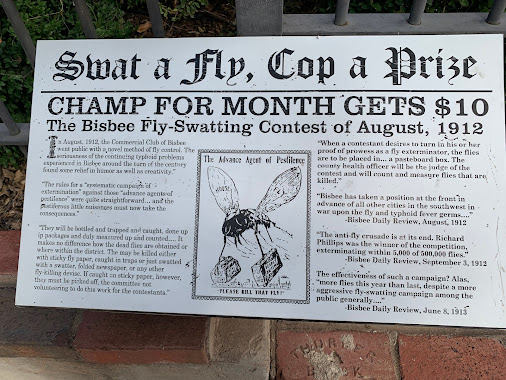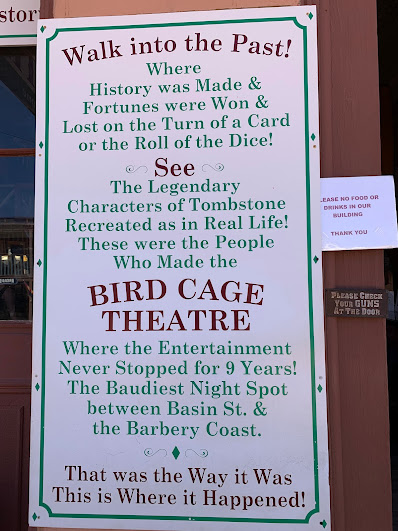The next day we visited Tombstone. Once again, we'd been here before but it had been awhile. I'm not sure we were dying to get there, though.
Tombstone was founded in 1879 by prospector Ed Schieffelin in what was then Pima County It became one of the last boomtowns in the American frontier. The town grew significantly into the mid 1880s as the local mines produced $40-80 million in silver bullion, the largest productive silver district in Arizona. The population grew from 100 to around 14,000 in less than seven years. It is best known as the site of the Gunfight at the O.K. Corral and today draws most of its revenue from tourism.
The town was established on a mesa above the Goodenough Mine. Within two years of its founding, although far distant from any other metropolitan area, Tombstone had a bowling alley, four churches, an ice house, a school, two banks, three newspapers, and an ice-cream parlor, alongside 110 saloons, 14 gambling halls, and numerous dance halls and brothels. The ladies and gentlemen of Tombstone attended operas presented by visiting acting troupes at the Schieffelin Hall opera house, while the miners and cowboys saw shows at the Bird Cage Theater and brothel.
Our first stop was the site of the Gunfight at the O.K Corral.
The gunfight occurred on October 26, 1881 and lasted less than a minute, 30 seconds according to some testimonies. It is generally regarded as the most famous gunfight in the history of the American Old West.
The gunfight was the result of a long-simmering feud. Cowboys Bill Claiborne, brothers Ike and Billy Clanton, and brothers Tom and Frank McLaury were on one side. On the other side were Deputy U.S. Marshal and Town Marshal Virgil Earp, his two brothers and Special Policemen Morgan and Wyatt Earp, and temporary policeman (and best friend of Wyatt) Doc Holliday. Billy Clanton and both McLaury brothers were killed while Ike Clanton and Billy Claiborne ran from the fight. Virgil, Morgan and Holliday were wounded, but Wyatt was unharmed. Virgil made the decision to enforce a city ordinance prohibiting carrying weapons in town and to disarm the Cowboys. Although Wyatt is often erroneously regarded as the central figure in the shootout, he was only a temporary assistant marshal to his brother.
Wyatt Earp drew this map in 1924.
A life-size replica makes it easier to visualize (my dad loved to visualize things). Cowboys in the foreground, Earps and Holliday in the back with Wyatt right next to the window.
Some interesting items.
This antique 1860s plantation saddle was ridden by Kurt Russell when he played Wyatt Earp in the movie Tombstone. The saddle was used in the scene where Wyatt first meets and rides with Josephine Marcus, the woman who would later become his common-law wife.
We walked through town which has been kept fairly authentic.
It was lunch time so we wandered around looking for someplace to eat.
We didn't stop so didn't try the coldest beer in town
The miners and cowboys favorite place to frequent. But we didn't stop.
Nor did we stop here.
We finally settled on this place.
The Crystal Palace was originally established in 1879 as the Golden Eagle Brewery and started off as a significant hub of activity in town. Tragedy struck when the entire town was ravaged by a devastating fire in 1882, which reduced the Crystal Palace to ashes. However, the resilient spirit of the Palace persevered and it was soon rebuilt on the same spot and took on the new name of Crystal Palace Saloon.
Prohibition dealt a blow to the saloon, forcing it to close its doors temporarily but the spirit refused to fade away. After the ban on alcohol was lifted,, the Crystal Palace was meticulously restored to its former glory and reopened as a saloon, reinstating its position as a vibrant gathering place for locals and tourists.
The interior displays an authentic old-west atmosphere, with its wooden furnishings, period decor and a bar that has witnessed countless stories and conversations over the years.
From there we moved on to the Tombstone Epitaph.
The Epitaph is a monthly publication that covers the history and culture of the Old West. Founded in January 1880, with the first issue published on May 1, 1880, it is the oldest continuously published newspaper in Arizona.
In 1880, John Clum decided to relocate from Tucson to Tombstone. At one time Clum was the U.S. government appointee in charge of the San Carlos Apache Indian Reservation and while there, was the only U.S. authority to capture Geronimo, the renegade Apache, although he was later released.
Criticized by associates who said he would write an epitaph and not a newspaper, Clum was inspired to call his new publication The Tombstone Epitaph. Clum was among the group of townspeople who supported the Earp brothers as they attempted to enforce law and order in Tombstone.
The first issue was printed on this press. This is a "Washington Hand Press" and was built in New York City in 1856. It was carried by ship around South America through Cape Horn to San Francisco. The press was originally used to print various newspapers in California gold mining towns.
In 1880, John Club bought the press and had it shipped by train from San Diego to Tucson, then brought by freight wagon to Tombstone. The press was advanced in its day and had a number of automatic devices that speeded printing, but it was still operated by hand and was used for many years to print the Epitaph.
As we drove out of town we stopped at the Boothill Graveyard, a small graveyard of at least 250 interments. It is also known as the "Old City Cemetery" and was used only to bury outlaws and a few others. It has a separate Jewish cemetery nearby. "Boot Hill" refers to the number of men who died with their boots on.
More on the Jewish Memorial in a minute
This sure is an historic place!
Hanged by mistake??????
Fred White was the first town marshal (equivalent to chief of police) in Tombstone and was elected in January, 1880. He was killed while in office, on October 30, 1880, and was succeeded by Virgil Earp.
It was then that, as we often do, we talked about where some of these people were buried. And then it came to us - Wyatt Earp is buried in the Jewish cemetery in Colma where my Gunzendorfer peeps are interred. And we were there years ago to visit them! You can read about my visit to Hills of Eternity
HERE.
Why a Jewish cemetery you ask? His third wife, Josie, was raised Jewish and Wyatt had agreed to be buried in her family plot despite not being Jewish himself. Earp died peacefully at the age of 81 in Los Angeles with Josie at his side. Josie was so grief stricken that it is said she could not even attend the funeral. After the funeral, Earp was cremated and his ashes were taken to Colma, California and interred in the Jewish section of the Hills of Eternity Cemetery. When Josie died, she too was cremated and buried in the plot, assuring that the husband she so adored would never be alone again. Quite an end for the complicated Wyatt Earp.
A nice way to end the day of travel, history, and genealogy.
















































